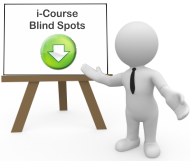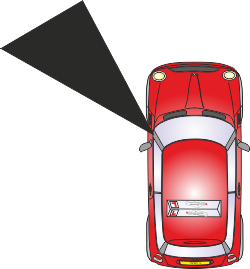Blind spots project
 There have, sadly, been several tragedies over the years where small children have been killed or seriously injured because the driver did not know that they were in the path of his/her vehicle (either in front or behind).
There have, sadly, been several tragedies over the years where small children have been killed or seriously injured because the driver did not know that they were in the path of his/her vehicle (either in front or behind).
The bonnet and boot (or rear door) create a blind-spot that can extend for several feet. Anything less than two/three feet high can easily be hidden from view (As the SmartDriving Training Director found to his cost in 1986 when he reversed his driving school car into a concrete bollard – repairs £990.00)
As an experienced driver you will be aware of the concept of 'blind spots', but how deeply have you considered the blind-spots in your own vehicle?
This short project is designed to ensure that you have a full appreciation of the areas around your car that are hidden from view when you are sitting in your normal driving position and to raise your awareness of the 'observation strategies' that you currently use to overcome blind spots.
When using the term 'blind-spots' most people are simply referring to the areas not covered by rear-view mirrors, however, these are not the only 'problem areas' for the driver. For example, what limitations does the car's structure pose when emerging at junctions or manoeuvring in a car park?
Next: After completing the project on this page move on to Step 4 - Stopping.
With the driving seat adjusted normally, make a plan of the areas of view that are blocked by the car's structure and the areas not covered by the driving mirrors.
Note any action required to overcome problems caused by each blind spot. (Clue: There is at least one blind  spot that you might have to get out of the car to check)
spot that you might have to get out of the car to check)
This image will get you started. It shows the approximate blind area created by the front offside windscreen pillar. How would you compensate?
Now go for a drive (about 40 minutes) with lots of junctions. If possible, include a busy supermarket or multi-storey car park, and park your car by both reversing and driving into a space.
Note how the blind-spots identified in 'Step 1' affect you (or could potentially affect you in slightly changed circumstances - perhaps a toddler in a car park) and what you have to do to compensate in each situation.
Be aware of your position in the seat at all times. Much of your 'compensation' will be so natural that you might not be aware you are doing it (leaning forward , etc.).
When you start spending time in the instructor's seat you will also have to consider not only the blind spots caused by vehicle structure, but also the blind spots to the right caused by the presence of your pupil.
In addition you must be ensure that you are seated so that you don't impede your pupil's view to the left (and teach your pupils about the blind-spot dangers caused by passengers!).